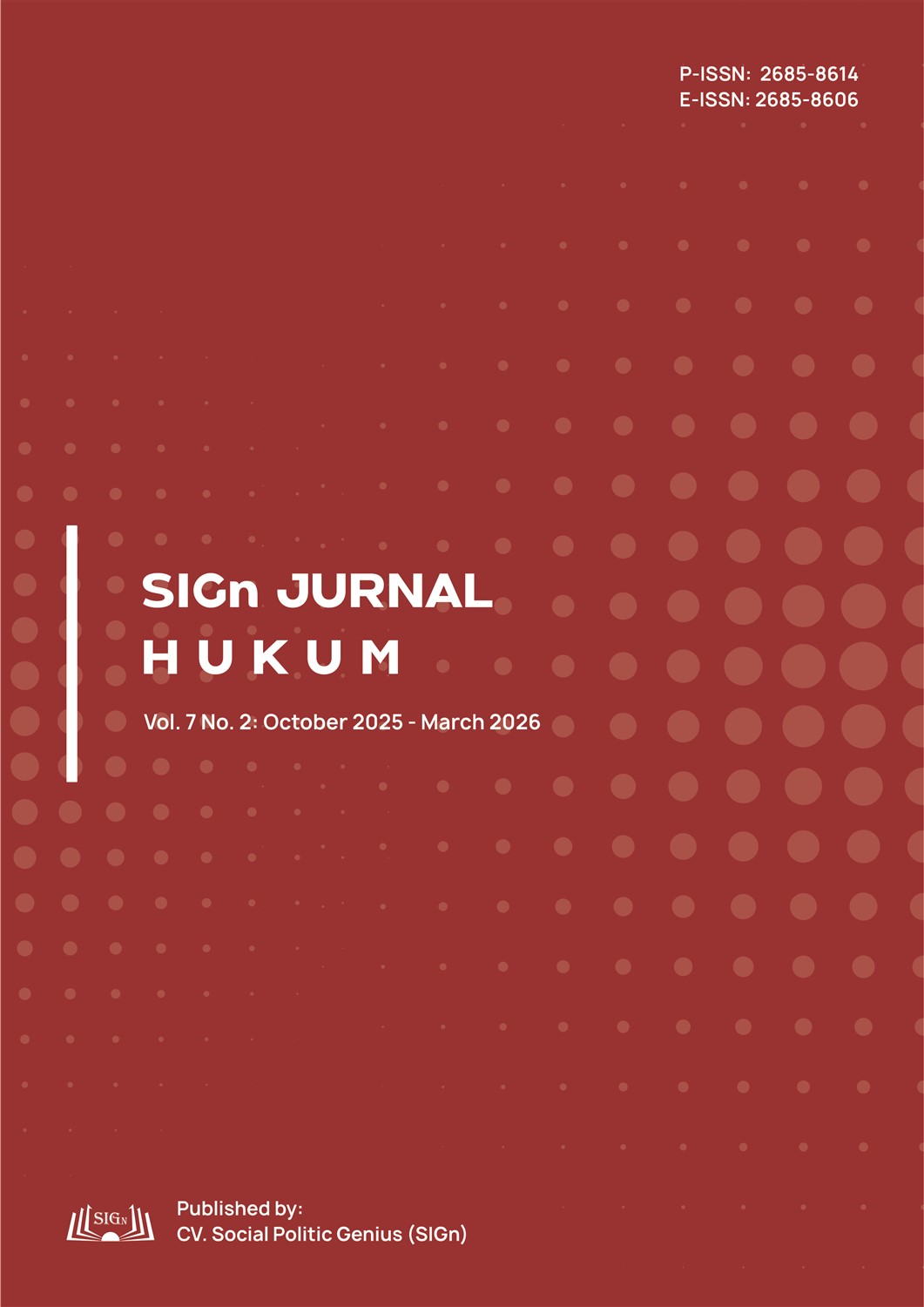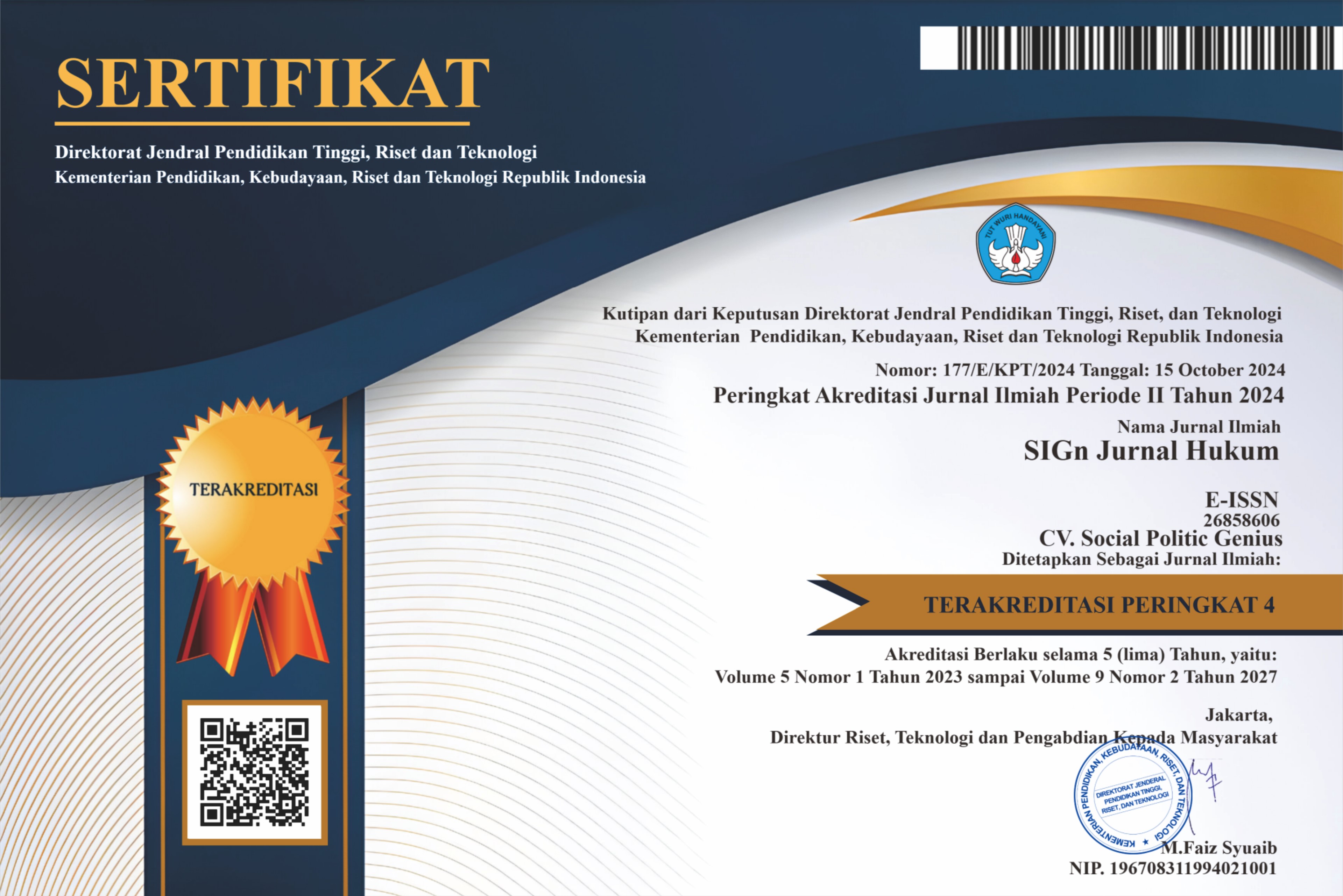Judicial Law-Finding in the Criminal Justice System: Harmonizing Legal Certainty and Substantive Justice
Abstract
The enactment of Law Number 1 of 2023 marks a fundamental paradigm shift in the Indonesian criminal justice system, prioritizing substantive justice over formal legal certainty. This shift radically transforms the role of a Judge from a mere mouthpiece of the law (bouche de la loi) to an active law-finder (rechtsvinder). However, the practice of law-finding in the field remains largely ad hoc and intuitive, creating a risk of inconsistency. Addressing this urgency, this research aims to formulate a systematic and accountable ideal concept of judicial law-finding to serve as an operational guide for Judges. Using a normative juridical method that integrates a statute approach, a conceptual approach, and a case approach to key court decisions, this study conducts a methodological reconstruction of the practice of judicial discretion. The primary finding is the formulation of a “judicial compass” built upon five mutually reinforcing fundamental principles: (1) proportionality, (2) transparency and accountability, (3) judicial consistency, (4) social responsiveness, and (5) dynamic equilibrium. These five principles collectively transform the law-finding process into a structured and rational approach. Thus, this ideal concept contributes both theoretically and practically by offering a coherent framework for Judges to execute the mandate of Law Number 1 of 2023, enabling them to harmonize legal values justly and measurably in every decision.
Downloads
References
Alfikri, A. F. S., & Rahmatullah, M. A. (2024). Interfaith Marriage from a Legal Justice Perspective after the Supreme Court’s (SEMA) 2023 Circular Letter. Alauddin Law Development Journal, 6(1), 92-107. https://doi.org/10.24252/aldev.v6i1.44215
Circular of the Supreme Court of the Republic of Indonesia Number 4 of 2011 on the Treatment of Whistleblowers and Justice Collaborators in Certain Criminal Cases. https://jdih.mahkamahagung.go.id/legal-product/sema-nomor-4-tahun-2011/detail
Fatoni, S., Rusdiana, E., Rosyadi, I., & Rozikin, O. (2025). Asas Proporsionalitas: Perspektif Hukum Positif dan Maqosid Syariah dalam Sistem Peradilan Pidana. Jurnal Hukum Ius Quia Iustum, 32(1), 46-71. https://doi.org/10.20885/iustum.vol32.iss1.art3
Firmansyah, A., Setiawan, D., Pratama, F., Marwan, T., Almanda, A., Oktarianda, S., Zulkarnen, Z., Satrio, I., Saputra, I., Juna, A. M., & Rohman, R. (2024). Putusan Pengadilan Sebagai Sumber Hukum Yurispudensi. Wathan: Jurnal Ilmu Sosial dan Humaniora, 1(2), 136-146. https://doi.org/10.71153/wathan.v1i2.79
Firmansyah, R. A., Widjaja, M., Kusumawardani, C. E., Sugianto, F., & Indradewi, A. A. (2025). Justice Collaborator at a Legal Crossroads: An Analysis of the Tension between Substantive Justice and Legal Certainty. SIGn Jurnal Hukum, 7(1), 368-384. https://doi.org/10.37276/sjh.v7i1.479
Hardiansyah, R., Siregar, M. Y., & Tampubolon, W. S. (2024). Disparity in the Charges of Customs Crimes: A Study of Decision Number 42/Pid.B/2024/PN Rhl and Decision Number 43/Pid.B/2024/PN Rhl. SIGn Jurnal Hukum, 6(2), 144-156. https://doi.org/10.37276/sjh.v6i2.373
Harini, M., & Rahmat, D. (2025). Peran Hakim Pada Proses Penemuan Hukum Sebagai Upaya Penegakan Keadilan Berdasarkan Kode Etik Hakim. Journal Evidence of Law, 4(1), 207-230. https://doi.org/10.59066/jel.v4i1.1097
Hartoyo, H., Soekorini, N., & Handayati, N. (2023). Application of the Principle of Legality in the Criminal Justice System: Ensuring Justice and Protection of Human Rights. Endless: International Journal of Future Studies, 6(2), 254-266. https://doi.org/10.54783/endlessjournal.v6i2.174
Hiariej, E. O. S., & Santoso, T. (2025). Anotasi KUHP Nasional. PT. Raja Grafindo Persada.
Holili, H., Yunus, M., & Winarto, W. (2024). Kedudukan Yurisprudensi sebagai Sumber Hukum di Indonesia sebagai Penganut Sistem Civil Law. COMSERVA: Jurnal Penelitian dan Pengabdian Masyarakat, 3(9), 3718-3726. https://doi.org/10.59141/comserva.v3i09.1140
Irwansyah. (2020). Penelitian Hukum: Pilihan Metode & Praktik Penulisan Artikel. Mirra Buana Media.
Jaya, K., Sufriaman, S., & Halim, M. (2022). Menelisik Putusan Hakim dalam Tindak Pidana Kesusilaan Pada Putusan Nomor: 06-K/PM/III-16/AL/I/2017. Buletin Poltanesa, 23(2), 540-550. https://doi.org/10.51967/tanesa.v23i2.2043
Laia, F. F. D. (2024). Restorative Justice and Living Law Based on Dayak Ngaju Adat Law: A Comprehensive Analysis. SIGn Jurnal Hukum, 6(2), 68-84. https://doi.org/10.37276/sjh.v6i2.363
Laia, F. F. D. (2024). The Urgency of Enacting Government Regulation on Community Service Sentence in Indonesian under the New Penal Code. SIGn Jurnal Hukum, 6(1), 1-16. https://doi.org/10.37276/sjh.v6i1.350
Law of the Republic of Indonesia Number 1 of 1946 on the Penal Code Regulations. https://www.dpr.go.id/dokumen/jdih/undang-undang/detail/814
Law of the Republic of Indonesia Number 8 of 1981 on the Code of Criminal Procedure (State Gazette of the Republic of Indonesia of 1981 Number 76, Supplement to the State Gazette of the Republic of Indonesia Number 3209). https://www.dpr.go.id/dokumen/jdih/undang-undang/detail/755
Law of the Republic of Indonesia Number 13 of 2006 on the Protection of Witnesses and Victims (State Gazette of the Republic of Indonesia of 2006 Number 64, Supplement to the State Gazette of the Republic of Indonesia Number 4635). https://www.dpr.go.id/dokumen/jdih/undang-undang/detail/69
Law of the Republic of Indonesia Number 35 of 2009 on Narcotics (State Gazette of the Republic of Indonesia of 2009 Number 143, Supplement to the State Gazette of the Republic of Indonesia Number 5062). https://www.dpr.go.id/dokumen/jdih/undang-undang/detail/568
Law of the Republic of Indonesia Number 48 of 2009 on the Judicial Power (State Gazette of the Republic of Indonesia of 2009 Number 157, Supplement to the State Gazette of the Republic of Indonesia Number 5076). https://www.dpr.go.id/dokumen/jdih/undang-undang/detail/585
Law of the Republic of Indonesia Number 31 of 2014 on Amendment to Law Number 13 of 2006 on the Protection of Witnesses and Victims (State Gazette of the Republic of Indonesia of 2014 Number 64, Supplement to the State Gazette of the Republic of Indonesia Number 4635). https://www.dpr.go.id/dokumen/jdih/undang-undang/detail/1613
Law of the Republic of Indonesia Number 1 of 2023 on the Penal Code (State Gazette of the Republic of Indonesia of 2023 Number 1, Supplement to the State Gazette of the Republic of Indonesia Number 6842). https://www.dpr.go.id/dokumen/jdih/undang-undang/detail/1818
Lestari, R. A., Rivanie, S. S., & Soewondo, S. S. (2023). Implementation of Restorative Justice for Narcotic Abusers: A Case Study in the Takalar Public Attorney’s Office. SIGn Jurnal Hukum, 5(1), 207-220. https://doi.org/10.37276/sjh.v5i1.275
Mahmud, Y., Akili, R. H. S., Kadir, Y., & Moonti, R. M. (2019). Restorative Justice dalam Putusan Hakim Nomor: 31/Pid.Sus/2018/PN.Lbto Atas Kasus Persetubuhan terhadap Anak. SIGn Jurnal Hukum, 1(1), 52-69. https://doi.org/10.37276/sjh.v1i1.37
Nasrullah, N. (2020). Putusan Hakim terhadap Pemberian Sanksi di Bawah Batas Minimal pada Tindak Pidana Narkotika. SIGn Jurnal Hukum, 2(1), 1-19. https://doi.org/10.37276/sjh.v2i1.59
Panu, A., Moonti, R. M., & Ahmad, I. (2025). Reformasi Sistem Peradilan Pidana Anak di Indonesia Antara Diversi, Restoratif, dan Perlindungan Hak Anak. Politika Progresif: Jurnal Hukum, Politik dan Humaniora, 2(2), 276-293. https://doi.org/10.62383/progres.v2i2.1885
Paramarta, A. (2018). Judicial Mafia in Criminal Justice System and Its Countermeasure. Jurnal Hukum Novelty, 9(2), 160-171. https://doi.org/10.26555/novelty.v9i2.a11263
Qamar, N., & Rezah, F. S. (2020). Metode Penelitian Hukum: Doktrinal dan Non-Doktrinal. CV. Social Politic Genius (SIGn).
Qamar, N., & Rezah, F. S. (2022). The Dichotomy of Approach in the Study of Legal Science: A Critical Review. SIGn Jurnal Hukum, 4(2), 191-201. https://doi.org/10.37276/sjh.v4i2.162
Rahmat, D., & Umar, S. B. N. (2023). Law Enforcement in Criminal Cases Based on Restorative Justice by the Prosecutor’s Office. East Asian Journal of Multidisciplinary Research, 2(8), 3399-3408. https://doi.org/10.55927/eajmr.v2i8.5761
Rezah, F. S., & Muzakkir, A. K. (2021). Custom as a Critical Concept and Siri’ as the Core Concept of Ugi-Mangkasara Culture. SIGn Jurnal Hukum, 3(1), 40-51. https://doi.org/10.37276/sjh.v3i1.123
Romdoni, M., & Fitriasih, S. (2022). Disparitas Pemidanaan dalam Kasus Tindak Pidana Khusus Narkotika di Pengadilan Negeri Tangerang. Masalah-Masalah Hukum, 51(3), 287-298. https://doi.org/10.14710/mmh.51.3.2022.287-298
Sampara, S., & Husen, L. O. (2016). Metode Penelitian Hukum. Kretakupa Print.
Selajar, S. Y., & Martha, A. E. (2023). Indonesian Criminal Code, Living Law and Control in Law Enforcement in Indonesia. Sasi, 29(4), 705-716. https://doi.org/10.47268/sasi.v29i4.1697
Suherman, A. (2019). Implementasi Independensi Hakim dalam Pelaksanaan Kekuasaan Kehakiman. SIGn Jurnal Hukum, 1(1), 42-51. https://doi.org/10.37276/sjh.v1i1.29
Suparno, S., & Jalil, A. (2022). Penemuan Hukum oleh Hakim di Indonesia. Law, Development and Justice Review, 5(1), 47-59. https://doi.org/10.14710/ldjr.v5i1.15043
Wibowo, A., & Widiyasmoko, I. A. (2021). Pertimbangan Hakim dalam Penjatuhan Pidana di Bawah Minimum Khusus: Studi Perkara Tindak Pidana Narkotika. Undang: Jurnal Hukum, 4(2), 345-369. https://doi.org/10.22437/ujh.4.2.345-369
Copyright (c) 2025 Muhammad Irwan, Ali Rahman, Amaliyah Amaliyah

This work is licensed under a Creative Commons Attribution 4.0 International License.

















